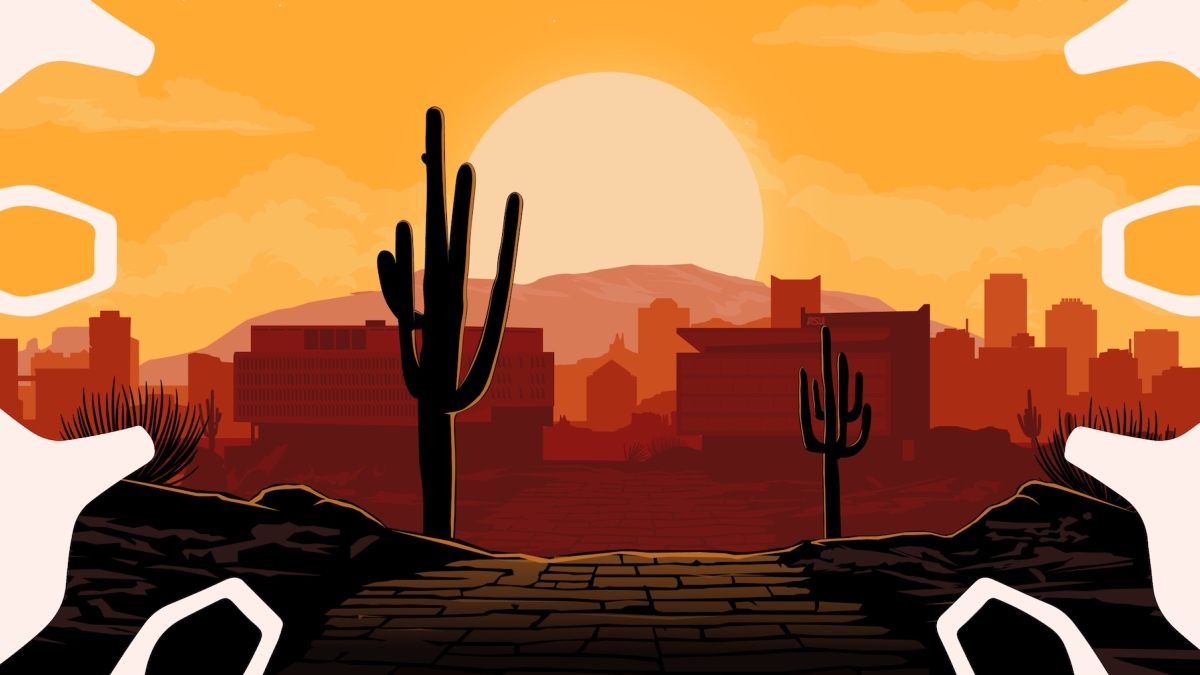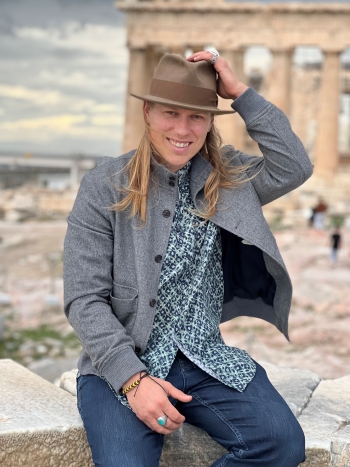ASU to host inaugural Carbon Summit

Illustration courtesy of Jason Marmon
Arizona State University President Michael M. Crow has called for "heroic sustainability" from academia, and ASU is taking a leadership position.
A big question remains, though: How does ASU become the first fully sustainable university?
A graduate student is helping create a roadmap to get there.
Jason Marmon has spent over a year organizing the inaugural Carbon Summit, which will be hosted at ASU's Rob and Melani Walton Center for Planetary Health on Nov. 15–16.
“The desert is a very energetic ecosystem, centering around sunshine and a delicate ecological balance. I believe the desert will respond well to proactive conservation strategies,” said Marmon, a management intern for University Sustainability Practices who is studying for two concurrent master’s degreesMarmon is pursuing M.S. degrees in Innovation and Venture Development and Applied Sustainability Solutions. . “Phoenix is the heart of the Sonoran Desert, the most prolific desert on Earth. Phoenix is also the hottest major metropolitan city in the United States, meaning we have a big need, so naturally, there’s an opportunity to lead and reimagine how solutions drive support for growing communities, capacity and resilience; it’s just what needs to be done.”
The Carbon Summit will serve as a discovery marketplace, showcasing sustainable solutions across five themes: food systems, energy transitions, circular economies, climate adaptation and sustainability. The focus on these themes aims to frame climate change challenges while promoting actions to balance carbon and desert futures.
Marmon took some time to speak to ASU News about the Carbon Summit event and his goals for the event.
Note: Answers have been edited for length and clarity.
Question: How did the idea for the Carbon Summit come about?
Answer: The Carbon Summit was an idea sparked during a Soil Health Academy in Caldwell, Idaho, led by regenerative agriculture experts Gabe Brown and Ray Archuleta ... The summer fires were terrible, and I realized the need for a platform to address pressing climate challenges, sustainability and agricultural issues. The vision of the event is to help find common grounds for common good; consensus and connectivity are the desired outcomes.
It’s really important to contextualize what I mean by carbon. I’m a carbon being, on a carbon planet, using carbon tech. Carbon is the energy molecule; without it, humans do not exist.
My background in sustainability and environmental policy, along with experience organizing community events and concerts as a promoter, drove me to double down on this mission. ... A new chapter started for me with a pilot of the Carbon Summit at the College of Idaho in 2021, then a stress-test at Boise State University in 2022. Today, we’ve found a home at ASU, an institution leading by example, well-equipped to support and scale these kinds of events and forward-thinking initiatives.
Q: Why ASU?
A: ASU embodies the core principles of innovation, entrepreneurship and sustainability — the "big three" in my book of fundamentals, which are needed to support initiatives like this. It's all about timing, alignment leadership and partnerships; ASU naturally fits the bill. While it will take some time to bring the right partners and stakeholders on board, the imperative of addressing climate challenges remains unchanged, and ASU is the ideal convenor for "heroic sustainability."
ASU's commitment to sustainability is remarkable. Its dedication to research, driving impact and implementing sustainable solutions aligns well with a vision of incubating and accelerating the benefits of the Carbon Summit. This event aims to be a generative MVP, enabling collaboration, communication and innovation; a model that can be shared with other institutions, event organizers and social entrepreneurs. Climate actions are most effective when they are local, applying what we’re learning in real time.
Having traveled to several top sustainability hubs, like Paris, Zurich, Amsterdam, Brussels, Rome and Athens, I can confidently say the opportunities and experiences I've encountered at ASU are unparalleled.
Q: Can you tell me more about your vision for the event?
A: The Carbon Summit event can be likened to planting a seed in good soil — in this case, the garden being ASU. This event concept envisions people's energy and attention as the essential input. ... The event's core purpose is to facilitate discussions and consensus-building, even connectivity intergenerationally. We need to build bridges and break down silos, we need to talk to each other, work together. There's a growing gap between the older and younger generations; they communicate differently.
The summit serves as a platform for spotlighting practical solutions and innovations that address pressing environmental challenges, framing ubiquitous problems. While acknowledging complex issues, the focus is on synthesizing solutions for local application. In this case, ASU is the experiment and the lab. From a student's perspective, global markets and politics may be beyond our immediate influence, but we hold sway within our local communities. This is where we hope to unite stakeholders, creating a "daisy-chain" effect to amplify our efforts for public benefit.
Importantly, the ASU Climate Action Fund can play a central role in bringing this event to fruition. We hope to grow the fund to provide vital financial support and resources needed to turn ideas into reality.
Q: Who is this event geared toward?
A: It's intentionally designed to serve as a catalyst for change across generations, recognizing the contrasting habits of older and younger generations in terms of consumption and communication. While the younger generation often leads the charge in demanding sustainability and climate actions, the event's mission extends beyond generational borders. It aims to foster a broader understanding and collective support for system-level changes that are vital for a sustainable future.
The key is to make big, complex problems simple to understand. If these problems are well understood, solutions can be designed, integrated and deployed. We’re essentially problem-solvers. My grandpa used to say, “A problem well-framed is a problem half-solved.”
This event is a welcoming space for anyone, yet we’re searching for the visionaries, innovators, students, concerned citizens and anyone deeply committed to contributing to a sustainable future.
Q: Who needs to be at the Carbon Summit?
A: Whether you're an environmentally conscious entrepreneur, an environmental advocate, a policymaker, a student driven to make a positive impact, or just a concerned citizen, your presence and insights are valuable. It's the diversity of perspectives, ideas and passions that will truly empower the summit to become a transformational change vehicle.
More Environment and sustainability

From environmental storytelling to hydroponics, student cohort crafts solutions for a better future
A select group of students from Arizona State University's College of Global Futures, a unit within the Julie Ann Wrigley Global Futures Laboratory, is laying the foundation to drive change…

2 ASU faculty elected as AAAS Fellows
Two outstanding Arizona State University faculty spanning the physical sciences, psychological sciences and science policy have been named Fellows of the American Association for the Advancement of…

Homes for songbirds: Protecting Lucy’s warblers in the urban desert
Each spring, tiny Lucy’s warblers, with their soft gray plumage and rusty crown, return to the Arizona desert, flitting through the mesquite branches in search of safe places to nest.But as urban…


